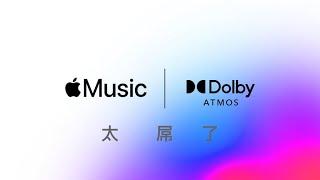Apple Music & Dolby Atmos: our test
In May 2021, Apple announced the conversion of its entire catalog – 90 million titles – to a new lossless format. Lossless really? Files in the new Apple Lossless Audio Codec (ALAC) format replace the catalog hitherto available in AAC (Advanced Audio Codec), a compression algorithm whose most advanced version already aimed to do better than MP3. ALAC is a lossless compression algorithm, in resolutions ranging from 16 Bits/44.1 kHz (CD quality) to 24 Bits/192 kHz. It remains a compression format despite everything, the objective being to facilitate the transport and transmission of music mainly consumed on the go on smartphones. With headphones or a Bluetooth headset, a protocol that does not allow the use of ALAC (or any other hi-fi format) at full resolution... In order to save storage space and improve throughput, the ALAC administers a compression rate close to 40 to 50% for music files in PCM format. The algorithm takes into account the parameters of hearing to skillfully deceive the brain of the listener, and this in a way that is almost undetectable for an untrained ear. Either.
Lossless and spatialized music
Where it takes on another dimension is when Apple partners with Dolby Laboratories. Another American company famous for having invented, among other things, noise reduction and multitrack encoding systems for the cinema, with optical then magnetic tracks directly printed on the film, as well as multitrack sound synchronized with the 4K digital image of our dark rooms.
The cinema experience tells us what Dolby Atmos – like its competitor DTS:X – brings to the listener. Namely a total immersion allowing to move a sound source laterally, but also from front to back, from bottom to top, and a combination of these three directions, in a truly 3D space. In the case of a control room like that of the Guillaume Tell studio, we work on a physical basis of 14 sound sources, in 9.1.4 (see box), which reflects exactly what can be heard in the best cinemas. movie theater.

What is valid for setting up an atmosphere, following a moving action or recreating a soundscape, wouldn't it be valid for listening to music seeking to reproduce the conditions of reality? Subject as old as the world; cavemen were not only painting in caves, but were already studying their resonant and reverberating faculties. Gregorian chant owes a lot to the acoustics of abbey churches. In 1610 Monte-verdi composed the Vespers of the Virgin by spatializing the choir and integrating the echo of the hall into his compositions. The quadraphony won homes in the 1970s, but also the concerts of Pink Floyd and progressive music groups of the time. In contemporary music, composers are closely interested in environmental electroacoustic techniques, and compose works intended to be performed by placing the public in immersion (Edgard Varèse, John Cage, Marc-André Dalbavie, etc.). In short, the field is immense, and without going as far as these ultimate experiences, the creative space is increased tenfold for artists and sound engineers…
The test
Deutsche Grammophon is one of the very first labels to invest in the production of multi-channel recordings in Dolby Atmos. Among the first releases available on Apple Music is Mahler's Symphony No. 8 "Des Mille", by the Los Angeles Philharmonic, a disc natively mixed in Dolby Atmos, with the involvement of conductor Gustavo Dudamel. Also at DG, “Echoes of Life” the recital by pianist Alice Sara Ott. Many records in Atmos are now available, in all musical genres.
At our disposal an iPhone 12 and an AirPods Max headset, usable via Bluetooth or wired with a Lightning cable. Wired, the only format supported is Lossless 24 Bit/48 kHz, resulting in excellent quality, with a strangely limited sound volume; in a Bluetooth AAC connection, the sound level available is significantly higher, and you have the choice, in the headset menu, to check or uncheck the Audio Spatial parameter. On almost the majority of the excerpts listened to, what Audio Spatial adds in terms of sound space and reverberation is done to the detriment of transparency and readability. It is perfectly recognizable on a solo violin, a voice or the playing of a piano. To put it another way, in one case we are in an all-encompassing way of listening, in a large hall, in the other in a more precise and more accurate hi-fi listening, closer to the performers.
So we come to sum it up as an artistic choice, that of the producer and the musicians on the one hand, and that of the sound engineer on the other. And there, it's a bit of a black box, since technology makes everything possible. We bet that these different actors will tame the tool to offer the listener a truly positive experience in listening to music. Except that it remains a challenge to fit 9.1.4 channels into a headset equipped with two transducers. And even if Apple Music is in no way engaged in the artistic debate, by promoting the format, it becomes an important player. With the idea that this will provide new opportunities for the music industry, and stimulate the creativity of artists and producers. Only the future will tell. Fortunately, the final choice is still left to the listener…



![PAU - [ Altern@tives-P@loises ] PAU - [ Altern@tives-P@loises ]](http://website-google-hk.oss-cn-hongkong.aliyuncs.com/drawing/179/2022-3-2/21584.jpeg)

![Good deal: 15% bonus credit on App Store cards of €25 and more [completed] 🆕 | iGeneration Good deal: 15% bonus credit on App Store cards of €25 and more [completed] 🆕 | iGeneration](http://website-google-hk.oss-cn-hongkong.aliyuncs.com/drawing/179/2022-3-2/21870.jpeg)





Related Articles